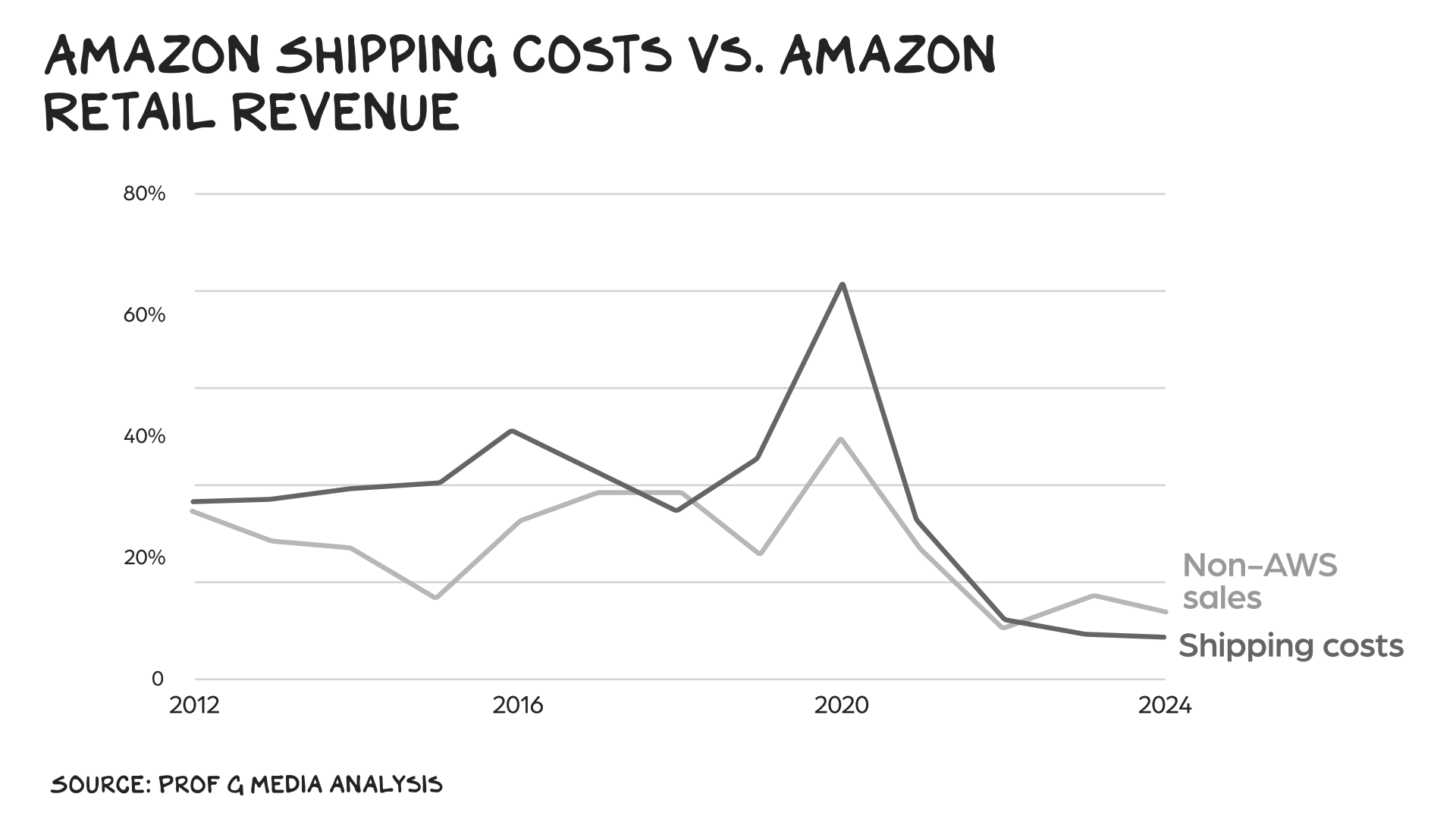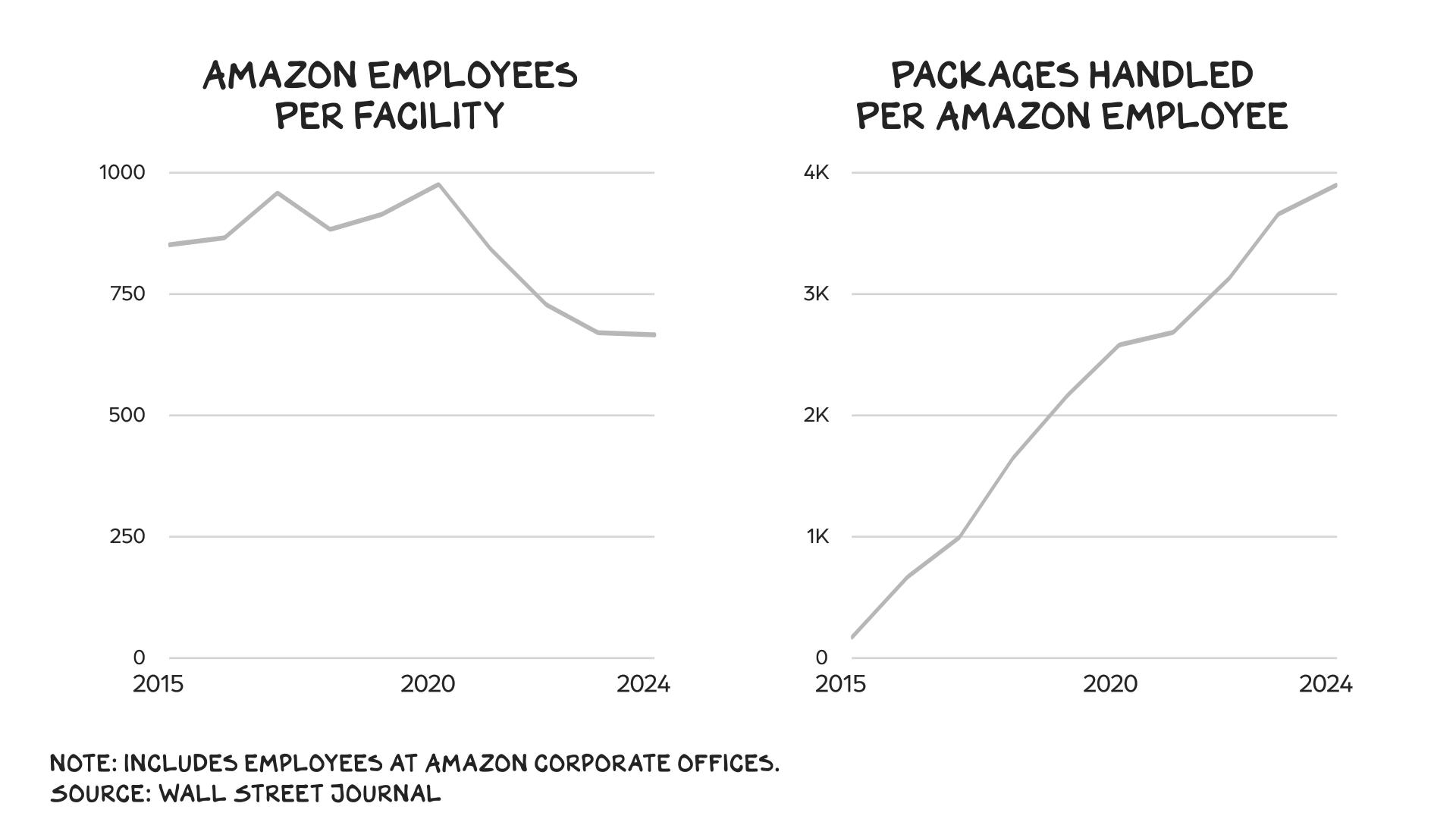
Big Tech Stock Pick of 2026: Amazon
At the end of every year, I pick a Big Tech stock I believe will outperform its peers in the coming year. My 2025 pick was Alphabet: I believed the market had overestimated the threats to Google’s search businesses by AI and antitrust. At the time, Alphabet was trading at a P/E ratio of 17, compared to the S&P average of 24. For Alphabet, these “existential” threats were akin to being trapped inside a speeding car with a wasp — potentially serious, in the moment, but in hindsight … more of a nuisance. Today, Google’s search share remains around 90%, and the company is integrating AI into its results. Google, not OpenAI, will likely continue to monopolize search. Speaking of monopoly, Alphabet lost its search and advertising lawsuits, but the remedy/punishment it was given was the equivalent of me threatening (again) to take my son’s phone away (i.e., meaningless). BTW, Alphabet is up 61% year over year, second only to Tesla in the Magnificent 7.
Stock of 2026
Where the market overestimated Alphabet’s existential threats, I believe it’s underestimating Amazon’s not-so secret weapon (automation) and missing its next growth engine (retail). For more than a decade, people thought of Amazon as a cloud company with a retail unit. AWS and the ad business drove its margin expansion, while on the retail side fulfillment and shipping costs increased faster than sales. Two years ago, Amazon began to reverse that trend. Investments in automation, primarily robotics but also AI, are beginning to deliver operational leverage.
Amazon is projected to have almost 40 delivery fulfillment centers equipped with robots by the end of next year, resulting in an estimated cost savings of $4 billion per year. A Morgan Stanley report estimated that if 30% to 40% of Amazon’s orders in the U.S. are fulfilled through its next-gen warehouses by 2030, the company could save $10 billion a year. Based on last year’s financials, $10 billion in cost savings translates to an additional $170 billion in enterprise value. As the Prof G Markets team observed in our other newsletter, investors are “pricing in AWS’s dominance, but missing the retail margin story,” making Amazon one of the most underappreciated members of the Mag 7. Amazon’s shares are trading at 34x earnings, well below the company’s five-year average of 60x. The stock had been up around 2% so far this year, but it popped after this week’s earnings call on news that AWS revenue had beaten expectations.

Atoms & Bits
One of technology’s tectonic unlocks has been the elevation of information (bits) over objects (atoms). Our digital lives are (mostly) frictionless. One-click purchasing, personalized algorithmic feeds, and swiping right put shopping, entertainment, and mating at our fingertips. But in the physical world, friction is the defining feature. To fulfill a one-click purchase, Amazon deploys armies of human workers, leveraging machines, global supply chains, and infrastructure. Five companies in the Mag 7 primarily move bits. One, Tesla, moves atoms. Straddling both worlds, Amazon is a logistics company at its core. With 40,000 semitrucks, 30,000 vans, and 110 aircraft (equivalent to the armed forces of Austria, Denmark, or Norway), Amazon excels at moving atoms. The company delivers 60% of Prime orders on the same or next day. According to the most recent data, almost three-quarters of Americans live within one hour of an Amazon fulfillment center.
Recently, I wrote that America’s economy is one big bet on AI. That bet has inflated the valuations of companies that move bits and distracted attention from companies using automation to reduce friction in the physical world. Two-thirds of Amazon’s revenue comes from three segments: online retail, physical stores, and fulfillment services for third-party sellers. Those business lines account for one-third of Amazon’s operating expenses — $26 billion in the last quarter alone. The more it automates, the more Amazon can cut costs in its core business by reducing real-world friction. It’s already happening. According to the Wall Street Journal, Amazon averaged roughly 670 employees per facility last year — the lowest number in 16 years. Meanwhile, those employees now handle 22x as many packages, on average, as they did a decade ago.

1 Million Robots (and Counting)
This week, Amazon announced plans to lay off 30,000 corporate employees. That 10% reduction represents the largest cut to headcount in the company’s history, but it’s a fraction of what’s coming for warehouse workers. Amazon’s U.S. workforce has increased 3x since 2018, to almost 1.2 million (70% of the company’s employees are based in the U.S.). But according to the New York Times, Amazon believes that by 2027 it can avoid hiring more than 160,000 workers it would otherwise need in America. Ultimately, Amazon believes it can automate up to 75% of the company’s warehouse operations.
Consider Amazon’s most recent automation milestone. In June, it deployed its millionth robot worker, putting the company on pace to have more robots than humans in its warehouses by yearend. I believe that, just as Mark Zuckerberg, Satya Nadella, and Sundar Pichai dream of AI replacing high-priced tech talent at Meta, Microsoft, and Alphabet, Amazon CEO Andy Jassy dreams of a robot workforce that will never unionize, get injured, demand a raise, go to the bathroom, take time off, or post about poor working conditions on social media. At Amazon’s scale, it’s not a robot workforce, but a robot nation. One of the fears about AI is that it could build a robot army that turns on us. It’s here, it’s Amazon, and (so far) it’s not looking to kill us. It will replace a lot of us, though.

Convergence
Amazon began investing in robotics a decade ago, purchasing Kiva Systems for $775 million. Since then, Amazon has identified six categories of automation: movement, manipulation, sorting, storage, identification and packing. A robot called Hercules moves heavy carts, while another, Pegasus, sorts and shuttles packed orders. A robotic arm called Sparrow, designed to replace human pickers, is capable of handling 200 million different products of varying sizes and weights. A new address labeler can label 3,000 packages per hour. In tests, Amazon says Sequoia, an automated inventory management system, can process packages 25% faster than its current management system at a quarter of the cost.
This year, Amazon plans to spend $100 billion to capture what Jassy called a “once-in-a-lifetime business opportunity,” adding that “the vast majority of that capex spend is on AI for AWS.” But investments in AI are paying dividends in robotics as the technologies converge. As a Citigroup report put it, “AI is a huge upgrade to robotics,” allowing robots to see, move, talk, learn, and act. It’s the difference between a robot programmed to perform a task and one capable of doing any task within its physical constraints. If you’ve taken a Waymo, you’ve seen convergence firsthand — the car is a robot operated by an AI driver. At Amazon, the peanut-butter-and-chocolate combo of AI and robotics shows up in three ways:
- New products: Amazon is testing AI-enhanced robots that can cut open boxes, unpack the contents, and sort them into the correct bins.
- Faster development: Amazon deployed its newest robotic arm, Blue Jay, 3x faster than its predecessors by using AI to make virtual prototypes.
- Optimization: DeepFleet uses AI to coordinate the movement of robots across Amazon’s fulfillment network, improving robot fleet travel time by 10%.
Holy Unlock
Unlike other jobs, loading and unloading trucks is primarily done by humans even in the most automated warehouses. It’s the same story for last-mile delivery; Amazon’s goal is to deliver 500 million packages per year via drone by the end of the decade, but for now it relies on humans to deliver more than 6 billion packages annually. This is dangerous work, akin to playing Tetris with heavy weights, often in extreme heat or freezing cold. According to BLS data, transportation and warehouse workers sustain serious injuries at twice the rate of manufacturing workers and nearly 4x the rate of workers in mining, oil, and gas.
Last year, Tye Brady, chief technologist at Amazon Robotics, described the tactile skills and situational awareness needed to load and unload a truck as the “holy grail of robotics,” adding “we aren’t there yet.” We is the operative word. This year, DHL ordered 1,000 robot truck-loaders from Boston Dynamics. Through its $1 billion Industrial Innovation Fund, Amazon invested in Rightbot, a startup that designs robot truck-loaders. As soon as a robot truck-loader comes online, it’ll connect with two other robot systems — Cardinal and Proteus — that sort packages and move them to the loading dock. When that happens, some of America’s most dangerous jobs will (mostly) vanish.
Robots vs. Humans
Automation represents a massive wealth transfer from Amazon’s workers to its shareholders and customers. Leaked documents show the company hopes to automate away 600,000 jobs by 2033. An MIT study found that adding one robot to a local area reduces employment in that area by six workers. A 2019 Oxford Economics report estimated automation could displace 8.5% of the global manufacturing workforce by 2030. As with AI, it’s possible that robotics will increase GDP while reducing employment.
Five years ago, my friend Andrew Yang ran for President with the slogan “Humanity First.” He warned that we needed to prepare humanity if/when automation decimates labor. This year, President Trump’s Big Ugly Bill made 100% bonus depreciation permanent for machinery, robotics, and automation equipment, while simultaneously gutting healthcare, education, and social safety net programs.
Tax policies illuminate a nation’s values. Our policies suggest we want to birth robots faster and expedite the death of workers.
Life is so rich,

P.S. I’ll reveal the full list of my 2026 Predictions at a free live event hosted by Section. Sign up here.
20 Comments
Need more Scott in your life?
The Prof G Markets Pod now has a newsletter edition. Sign up here to receive it every Monday. What a thrill.


This was all predicted 30 years ago by Marshall Brain. Google “Marshall Brain Robotic Nation”. Well worth reading – he was a great writer.
Was. He committed suicide last year.
Amazon can automate 600k jobs to boost margins, but those are the same households paying for Prime and filling carts. At scale, do you shrink your own demand engine? Walmart may not match the robots, but it could inherit the displaced customer.
Fuck bezos and amazon and the horse they rode in on.
Yee Ha
Amen- HUMANITY FIRST!!
When do we start dreaming about electric sheep?
I think the United States will have to go to a 4 day work week, or less, in order to have more employees, at the same total cost, in order to keep the us from becoming Nigeria, with 10% living well and 90% on the verge of starvation.
My question is this: If 100% of the corporate world globally is successful at replacing all workers with some kind of automation, where will their customers come from?
That last bit about depreciation and reduced healthcare was so heavy. Keep up the good work Scott! The 1% needs more people like you! Let’s grab a beer next time you’re in NYC 😝
Isn’t one of the largest benefits of AI assisting software developers write code? This would apply to enterprise ubiquitously across all industries. Isn’t Amazon a major player running Anthropic and their own proprietary models on their own proprietary chips, almost becoming the defacto standard. Wouldn’t this be an immense market?
A few years ago, I watched a 60-minutes interview with the Chinese equivalent of the Secretary of Labor. He was asked what he thinks will be China’s biggest challenge in the 21st Century. His response stunned me a bit. He said: “What will we do with all the workers who are no longer necessary?” He is most worried about a severe surplus of labor as China continues to automate its production processes to meet rising global demand. He was expressing a concern that idle hands are the devil’s workshop, that maintaining civil order with massive unemployment would be China’s biggest challenge this century. It sounds like mayb we could be looking at a similar challenge.
Robots will likely come under Capital Expenditure. Temp staff paid minimum wage will come under Operating Expenditure. Opex is easier to justify to the CFO 99/100 over Capex, even if they pay a temp agency a 50-100% premium. The rise of our robot overlords will be inadvertently thwarted by the men in grey suits, although there may be little more than grunt work for most. Oh dear.
An inevitable journey perhaps but this country has a staggering large education gap of haves and have-nots. I wonder who will buy all that stuff from AMZN when the have-nots no longer have jobs?
So all the low skilled jobs get replaced making 100s of thousands/millions of people unemployed. Those people were wage-earning customers of the company that makes them redundant. How does that play out? Reduce company costs and reduce company customers! I don’t see Universal Basic Income anytime soon in the current rush to rip away government provided safety nets for the poor.
Excellent article, as usual. As I look at the market players these days, I wonder if some of them might be profitable, but bad for the country. I would not want to support that. It seems to me that Scott has broached that topic before, and I can’t think of a better person to do a deeper dive on this. Just a suggestion.
So no ethical concerns?
Anthony, why ethical? It’s sad that humans would be replaced by robots, but technological change is coming, and coming fast, and there’s absolutely nothing that can be done to stop it. Would you rather Amazon keep humans, but end up losing out to competition because of it? They’re simply doing what must be done.
There’s a difference between “can’t “ and “wont”. Of course we can slow the progress of tech development if it is ultimately harmful to the human race. Our tech overlords (who control our government and everyone in it) simply won’t allow it. The ultimate sociological result remains to be seen but perhaps massive worldwide civil unrest would realign our focus as a race toward each other instead of profit.
I can tell you have never been poor.
Go tour a Chinese factory (if they let you). Machines are doing nearly all of the work, that’s why they are the best manufacturing country and why most items sold on Amazon are low-cost Chinese goods. Is it unethical that they have over a billion people yet employ no one in their factories?
I happen to live in China & there is nothing like anything like you stated. Granted, automation is well underway with an added push with the official government policy of “Made in China 2025” but millions upon millions of workers are gainly employed in factories. Lets let Deep Seek summarize what is truly happening:
A major driver of this automation is the Chinese government’s industrial policy, “Made in China 2025.” Its goal is to transform China from a low-cost manufacturer to a global leader in high-tech industries. A key part of this strategy is the widespread adoption of robotics and smart manufacturing.
To summarize:
· “Fully Automated” Factories: Number in the low thousands at most, and are showcase projects for leading companies in sectors like automotive and electronics.
· Highly Automated Factories: Number in the tens of thousands and are becoming the new standard for large and medium-sized enterprises.
· The Overall Trend: China is automating at a breathtaking pace, but given its immense manufacturing base, the journey toward widespread “lights-out” factories is still in its early stages. The focus is on human-robot collaboration to boost productivity and quality, not on the complete elimination of human labor.